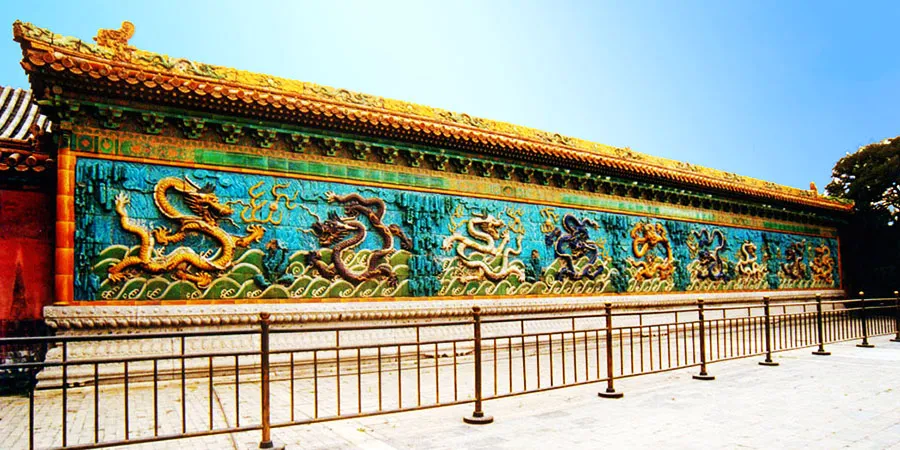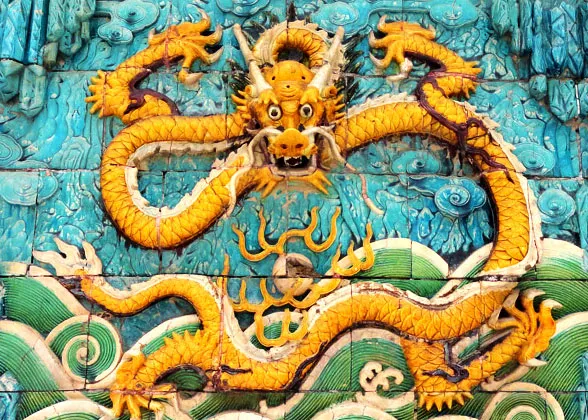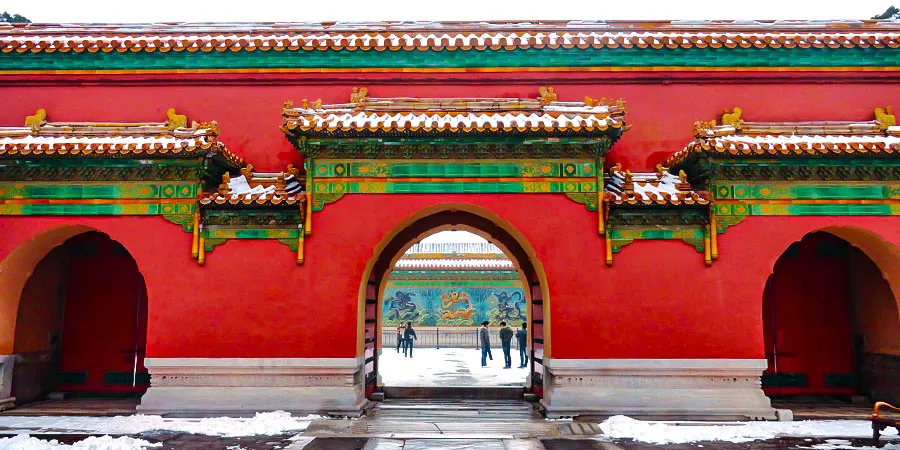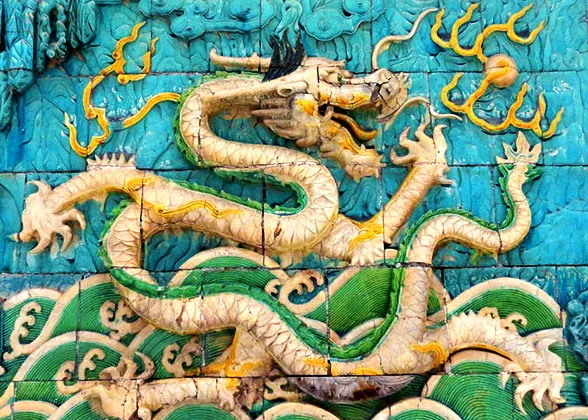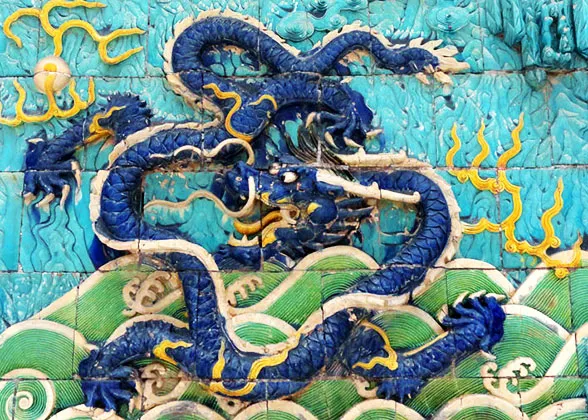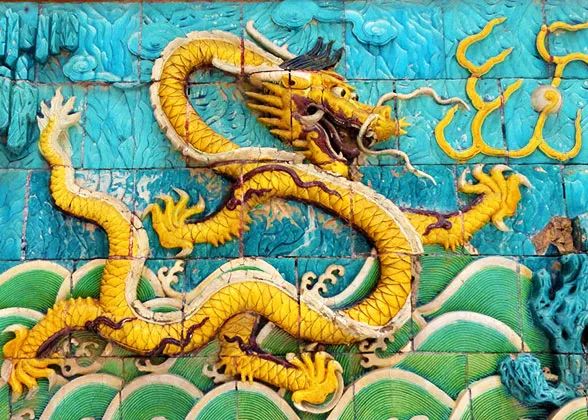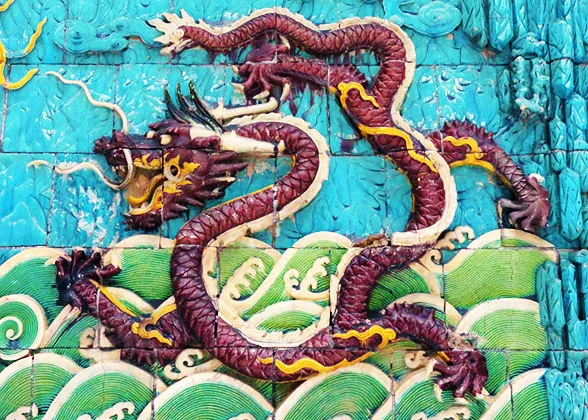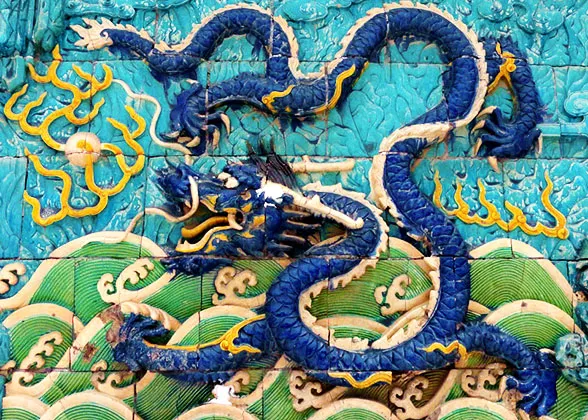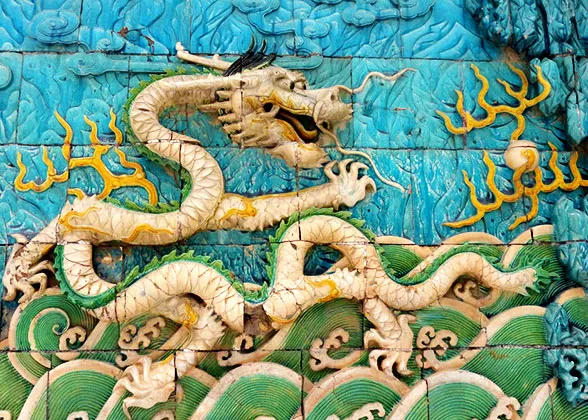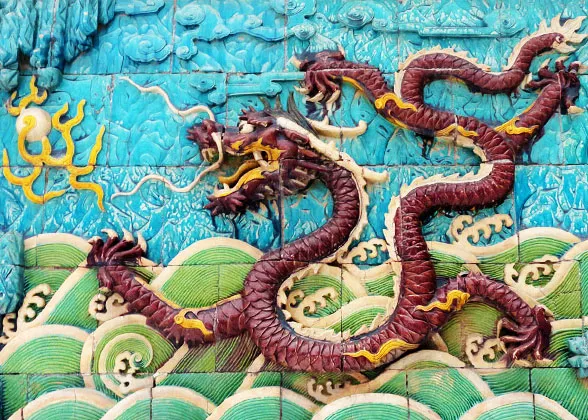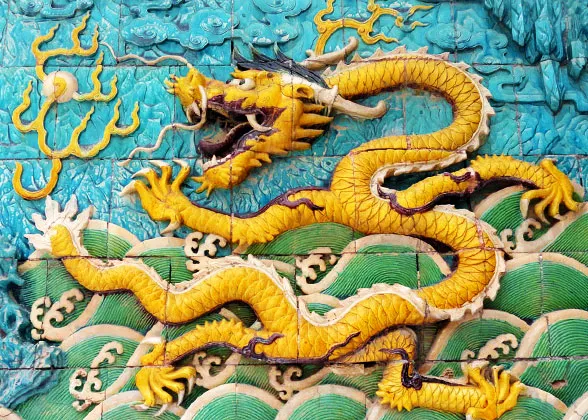To the south of the Gate of Imperial Supremacy, there stands a 29.4-meter-long and 3.5-meter-high glazed screen wall named the Nine Dragon Screen. The whole scene on the wall depicts nine writhing dragons playing with pearls against a background of the sea and clouds.
What are the nine dragons on the screen wall?
The Chinese dragon, represented yang, the principle of heaven, activity and maleness in the yin-yang of Chinese cosmology and from ancient times was the emblem of the imperial family. The Nine Dragon Screen therefore embodies an imperial symbol, along with precious artistic value that can be sought from the dragons in various vivid shapes and different colors.
At its very heart, there’s a kingly yellow dragon, glowing like a sunburst. With fiery gems clutched tightly in its front paws and its tail churning the waters below, the dragon commands respect with its coiled body and piercing eyes. It faces forward alone, a symbol of unchallenged imperial might.
Four Dragons on the Left

Ascending White Dragon: It raises head high, embodying progress and strength.

Descending Blue Dragon: Nestled innermost, it bends gracefully, tail swaying, symbolizing gentleness and acceptance.

Outer Yellow and Purple Dragons: The yellow one stands tall with spread claws, while the purple one presses down with its left claw and lifts its right, swinging its tail forward. They are competing for a pearl, adding dynamism.
Four Dragons on the Right

Descending Blue Dragon: It mirrors the left blue dragon but with a more relaxed posture, undulating with cloud and water patterns.

Ascending White Dragon: Raising its head, it raises its head triumphantly, echoing the left white dragon.

Outer Yellow and Purple Dragons: The yellow one bends and stretches, while the purple one raises its head and tightens its abdomen, in a scene of "braving the wind and the waves".
Digital Symbols of Nine Dragon Screen: 9 & 5
There are 9 dragons on the screen, with the 5th dragon stealing the spotlight as the centerpiece. Moreover, the wall is composed of 45 dragon-patterned arch bricks on the top and 270 glazed tiles, both can be divided by 9 and 5. Why did the designers choose to use 9 and 5 as well as their multiples in the construction of the screen wall?
In ancient China, the numbers 1, 3, 5, 7, and 9 were yang numbers of positive energy. Among them, 9 was revered as the peak of perfection, often associated with imperial power. 5, nestled in the middle, represented the emperor's pivotal role of both power and the universe. Together, they symbolized the supremacy of the emperor.
5 Interesting Tales about Nine Dragon Screen
Craftsman's Risky Deception: A Wooden Dragon Belly
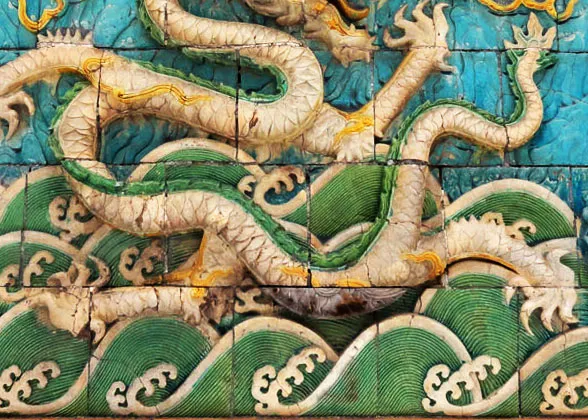 |
| Wooden Belly |
It is said that the center of the third white dragon was broke when fired in the kiln, which meant a death penalty for the people responsible. In the risk of death, a carpenter volunteered to replace the original with wood and did the carving and painting overnight. At last it passed and saved those involved. One may still find the traces of repair on the third dragon from the left.
Despite the dramatic story, however, some say it was just a weathering mishap that caused chunks of glaze to fall off after years, prompting this clever fix for beauty's sake.
Nine Dragon Screen & "Nine Princes' Contest for the Throne"
The screen showcases nine dragons, mirroring the nine princes contesting for the throne during Emperor Kangxi's late reign from 1708 to 1722. The dragons, with poses ranging from defiant lifts of the head to submissive bows, depict the intense power struggles.
As a result, Crown Prince Yinreng, once Kangxi's favorite, was deposed for insolence. Prince Yinzhen cleverly navigated the treacherous waters of royal intrigue and became the eventual victor. Upon ascending to the throne, he executed five of his brothers who posed a threat to his reign and imprisoned another two.
3D Carving of Dragon Heads: Royal's Cosmic Power
The dragon heads aren't just painted on; they're three-dimensional sculptures that stick out, ready to roar into the universe. The royal family insisted on this bold design, believing flat dragon heads lacked the power to command the cosmos.
Nine Dragons: Symbol of Qing Dynasty's Military Might
Tales also said that the central dragon represents the emperor—the ultimate ruler of all. Flanking him, eight other dragons coil and twist, each one a representation of the “Eight Flags”, Qing Dynasty's loyal forces guarding the emperor's throne.
Hidden Tenth Dragon Legend
Legend has it that a tenth dragon lurks behind the wall of the Nine Dragon Screen, emerging only during important festivals or royal celebrations to remind everyone of the emperor's unmatched power.
When Built – History of Nine Dragon Screen
In 1772, the Nine Dragon Screen was built in the Forbidden City. In the early years of the Republic of China (around 1912-1926), people discovered the wooden piece of the sculpture by the paint peeling off the third dragon’s belly. In 1949, bullet holes from the wartime were found on the Nine Dragon Wall, which were later repaired.
Are there any other Nine Dragon Screens in China?
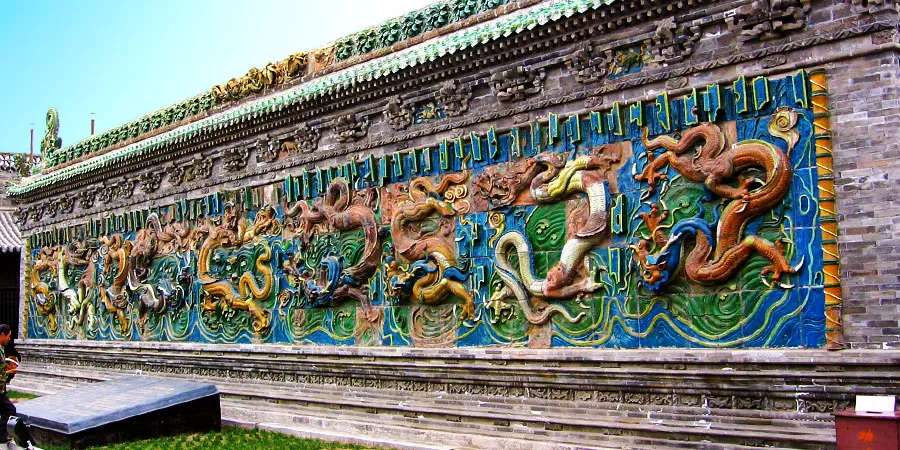 |
| Nine Dragon Screen, Datong, Shanxi |
There are totally three representative Nine Dragon Screens in China. Besides the one in the Forbidden City, the Nine Dragon Screen in Beihai Park, Beijing, is unique for dragons on both sides and boasts a remarkable total of 635 dragons, the highest count among all. Meanwhile,
the Nine Dragon Screen in Datong, Shanxi, built between 1392 and 1396, claims the title of the largest and oldest existing Nine Dragon Screen in China.
- Last updated on Aug. 01, 2025 by Gabby Li -
